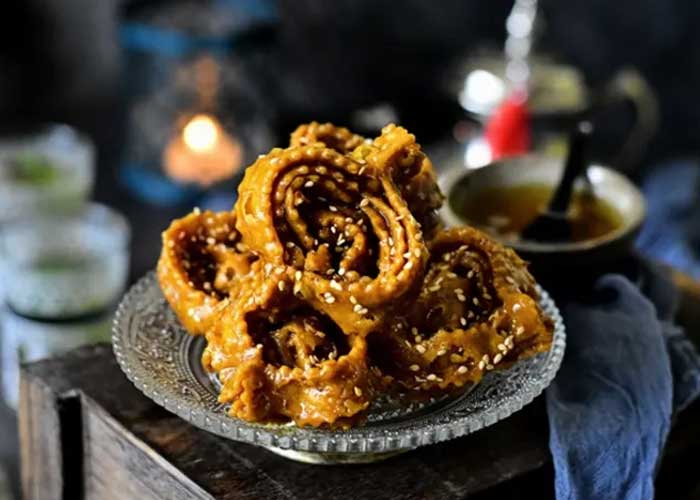Moroccan Cuisine – Top Recipes to taste in Morocco
Moroccan cuisine is a rich tapestry of flavors, textures, and cultural influences that reflects the country’s diverse history. Known for its bold and aromatic spices, it offers a harmonious blend of sweet and savory notes. Dishes like tagine, a slow-cooked stew of meat, vegetables, and fruits, showcase the artistry of Moroccan culinary traditions. Couscous, a staple made from semolina wheat, is often accompanied by a variety of succulent meats, vegetables, and aromatic broths. The liberal use of spices such as cumin, saffron, and cinnamon infuses dishes with depth and complexity. With its fusion of Berber, Arab, and Mediterranean influences, Moroccan cuisine embodies a culinary journey that delights the senses and exemplifies the nation’s vibrant cultural heritage.
Moroccan Couscous
Moroccan couscous stands as a quintessential symbol of the country’s culinary heritage and communal dining traditions. Made from semolina wheat that’s rolled into tiny granules, couscous serves as a versatile canvas for an array of flavors and ingredients. The preparation of couscous is as much an art form as it is a culinary technique, often involving multiple steamings to achieve its characteristic light and fluffy texture. It serves as a base for a variety of hearty stews, vegetables, and meats, creating a harmonious medley of tastes and textures. Dishes like the iconic “seffa medfouna” elevate couscous to a celebration centerpiece by combining it with caramelized onions, raisins, almonds, and aromatic spices, resulting in a sweet-savory symphony. Whether enjoyed in a family setting, at a festive gathering, or in the winding streets of a bustling souk, Moroccan couscous embodies the spirit of togetherness and the artistry of blending flavors that define Moroccan cuisine.
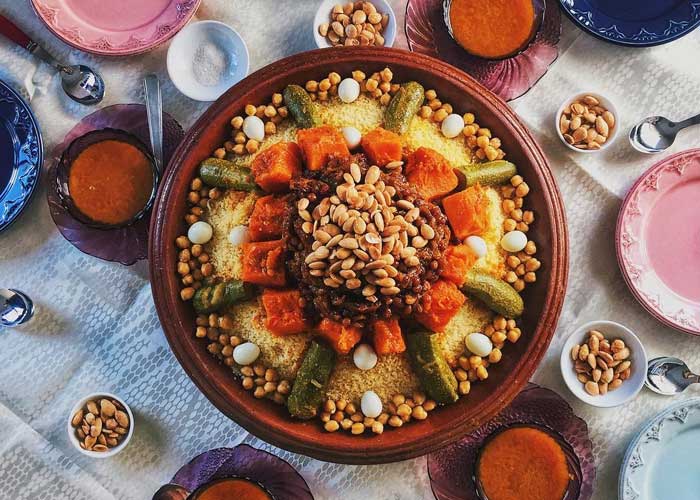
Moroccan Tagine
The Moroccan tagine, both a cooking vessel and the delectable dish it produces, captures the essence of Moroccan culinary ingenuity and cultural heritage. Shaped with a distinctive conical lid that allows condensation to circulate and flavors to intensify, the tagine pot is used to slow-cook a medley of ingredients into a harmonious masterpiece. The resulting tagine dish is a rich amalgamation of tender meats, vegetables, dried fruits, and an intricate blend of spices that transport the palate to the vibrant markets of Morocco. Whether it’s the iconic chicken tagine with preserved lemons and olives or the aromatic lamb tagine with apricots and almonds, each variation tells a unique flavor story deeply rooted in North African tradition. As the slow cooking process simmers the ingredients to perfection, the tagine embodies both the history of Moroccan gastronomy and the warmth of shared communal meals, making it a true culinary emblem of Morocco.
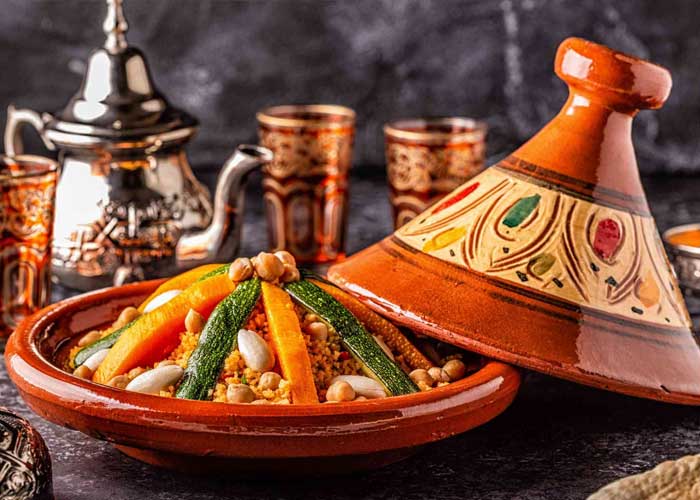
Moroccan Tea
Moroccan tea, also known as “Moroccan mint tea” or “Maghrebi tea,” is a cultural and social institution that encapsulates the hospitality and conviviality of Moroccan traditions. Prepared and shared with a meticulous attention to detail, this aromatic brew combines green tea leaves, typically Gunpowder tea, with a generous amount of fresh mint leaves and sugar. The tea-making process involves a series of pouring and steeping, traditionally performed from a height to create a frothy head. This ritualistic pouring not only mixes the flavors but also cools down the tea to a consumable temperature. The resulting tea is a delightful fusion of bitter, sweet, and refreshing mint notes that reflect the Moroccan approach to balance and harmony. Often served in small, intricately designed glasses, Moroccan tea accompanies conversations, celebrations, and moments of relaxation, fostering connections between people and representing the essence of Moroccan hospitality and culture.
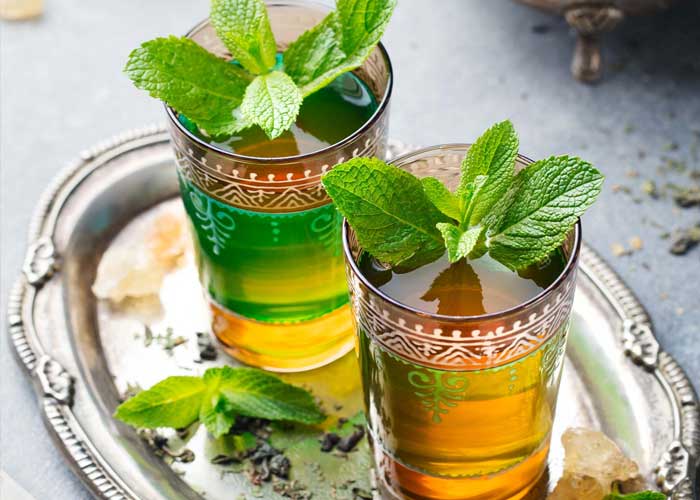
Moroccan Pastilla
Moroccan Bastila, also spelled as “Pastilla” or “B’stilla,” is an exquisite dish that epitomizes the elegance and complexity of Moroccan cuisine. This savory-sweet delicacy is a true testament to the blending of flavors and culinary artistry. Traditionally made with pigeon, though chicken is a common alternative today, the dish features a luscious filling of tender meat seasoned with aromatic spices such as saffron, cinnamon, and ginger. This flavorful mixture is enveloped in delicate layers of thin pastry, often phyllo dough, and baked to a golden perfection. What sets Bastila apart is its unique combination of flavors: the savory richness of the meat mingling with the nutty crunch of toasted almonds, all balanced by a dusting of powdered sugar and a sprinkling of cinnamon on top. This intriguing interplay of sweet and savory is a hallmark of Moroccan cuisine, and Bastila showcases it in a truly captivating manner. Often served on special occasions and celebratory feasts, Moroccan Bastila embodies the country’s culinary sophistication and the joy of savoring intricate layers of taste and texture.
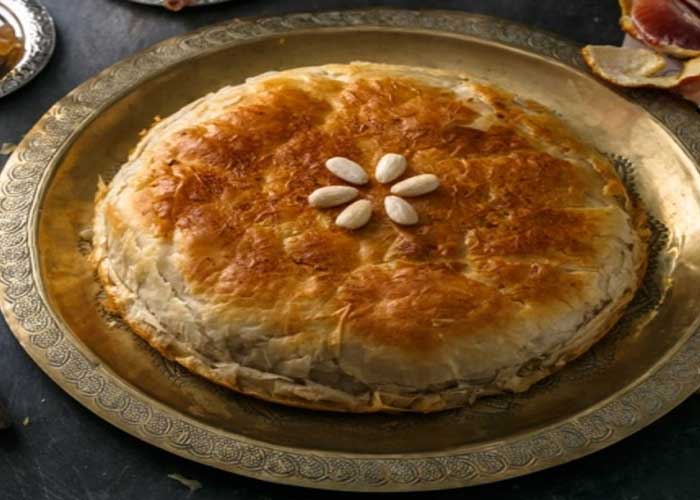
Kaab el Ghzal, Gazelle’s Horns
Gazelle’s Horns is a delectable Moroccan pastry that showcases the artistry of Moroccan sweets. With its delicate crescent shape resembling a gazelle’s horn, this pastry is a testament to the intricate craftsmanship that defines Moroccan culinary traditions. Made from a delicate, buttery pastry dough, Kaab el Ghzal is typically filled with a mixture of almond paste and aromatic flavors such as orange blossom water and cinnamon. The filling is encased in the dough and then shaped into its distinct crescent form. After baking to a golden hue, the pastries are often dusted with powdered sugar to add a touch of elegance. Kaab el Ghzal perfectly captures the balance of textures and flavors that Moroccan cuisine is known for, with the crispness of the pastry shell contrasting beautifully with the soft, fragrant almond filling. Often served during festive occasions, weddings, and celebrations, these pastries are not just a treat for the taste buds but also a reflection of Moroccan hospitality and the art of presenting food in an appealing and artistic manner.
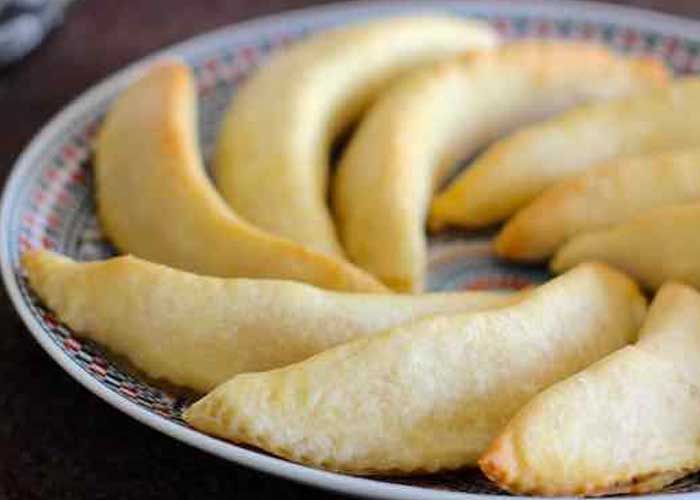
Tanjia el’ Marrakchia
The Tanjia is a distinctive Moroccan dish that reflects the city of Marrakech’s rich culinary heritage and the practical ingenuity of its people. Traditionally cooked in clay pots known as “tanjias,” this dish has its roots in the medina of Marrakech, where locals would prepare it and deliver it to the communal oven for slow cooking while they attended the Friday prayers. The Tanjia preparation involves marinating cuts of meat, often lamb, with a blend of spices like cumin, paprika, saffron, and garlic. Preserved lemons and olives are also frequently added for a burst of flavor. The marinated meat is then placed in the tanjia, sealed with a dough lid, and slow-cooked in the residual heat of the public oven for hours, resulting in tender, succulent meat infused with the rich flavors of the marinade. The Tanjia embodies the essence of Moroccan cuisine: the meticulous layering of spices and the unhurried cooking process that leads to a dish of unparalleled depth and complexity. Today, the Tanjia is not only a beloved dish enjoyed in Marrakech’s traditional eateries but also a symbol of Moroccan culinary heritage that captures the soulful essence of slow-cooked, communal meals.
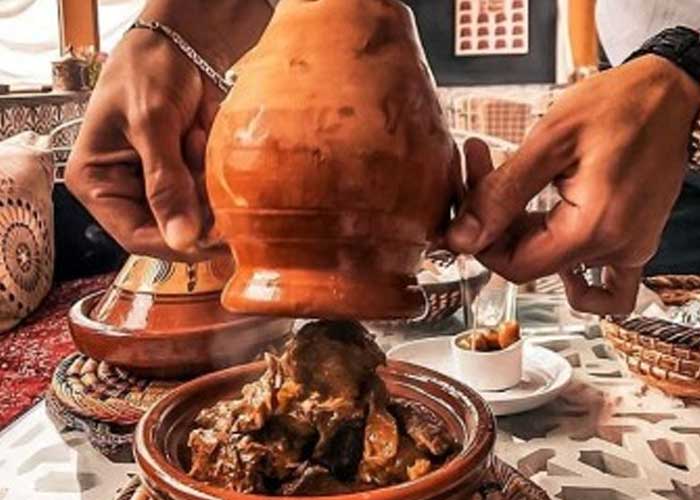
Moroccan Harira, Soup
Moroccan Harira, a beloved dish deeply woven into the cultural fabric of Morocco, is a hearty soup that comes to life with a fragrant blend of tomatoes, lentils, chickpeas, and an array of spices such as cinnamon, ginger, turmeric, and saffron. Its rich history and diverse regional variations make it a symbol of Moroccan unity, and during the holy month of Ramadan, it takes center stage as a comforting and nourishing meal to break the fast. The meticulous preparation, involving soaking and cooking lentils and chickpeas, blending tomatoes, and balancing spices, culminates in a velvety texture and harmonious flavors. Fresh herbs and a touch of lemon add a final flourish, making Moroccan Harira not just a soup, but a cultural experience that brings families and communities together.
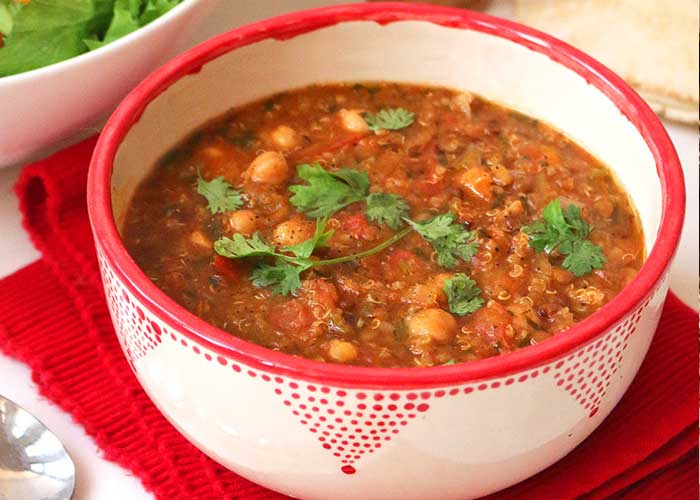
Chabakia or Shabakia
In the realm of Moroccan sweets, Chabakia reigns supreme as a cherished delicacy that embodies the artistry and joy of Moroccan culinary traditions. This intricate treat, often associated with special occasions and festive gatherings, is a testament to Morocco’s deep-rooted culture and the meticulous craftsmanship that goes into its gastronomy.
Chabakia, also known as “Chebakia” or “Shebakia,” is a pastry that transforms simple ingredients into a mesmerizing creation. The dough is made from a blend of flour, semolina, yeast, and spices such as anise, sesame, and saffron. What sets Chabakia apart, however, is its distinctive braided and twisted shape, resembling a rose or a hand, depending on the artisan’s interpretation. Shabakia most of the time served with Harira.
